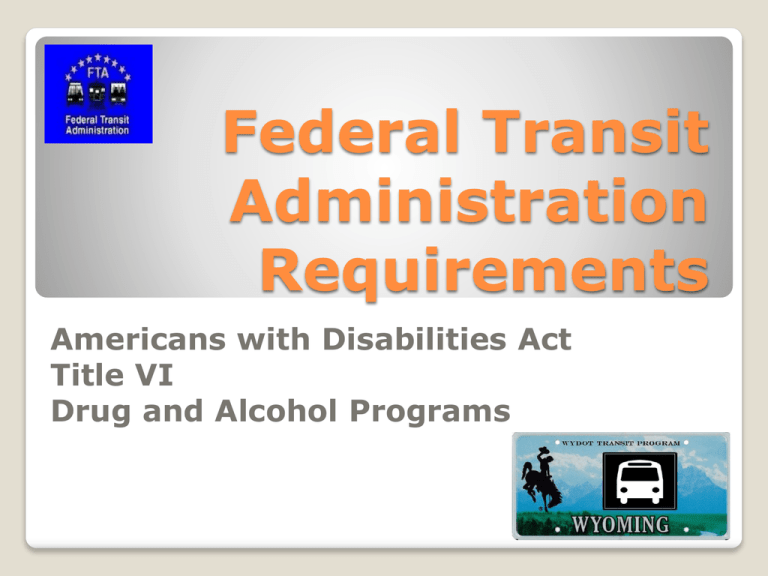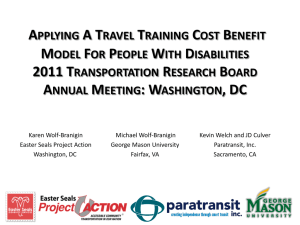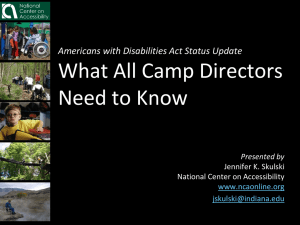
Federal Transit
Administration
Requirements
Americans with Disabilities Act
Title VI
Drug and Alcohol Programs
Basic Requirement:
Titles II and III of the Americans with
Disabilities Act of 1990 (ADA) provide that
no entity shall discriminate against an
individual with a disability in connection
with the provision of transportation
service.
Americans with Disabilities Act (ADA)
Where deficiencies are found:
Vehicle accessibility violations
Facility accessibility standards deficiency
ADA service provision deficiencies
ADA maintenance deficiencies
Complementary paratransit service deficiencies
Americans with Disabilities Act (ADA)
The FTA Office of Civil Rights conducts on-site assessments
of grantees’ compliance with ADA requirements for
lift/ramp use and maintenance, stop announcements and
route identification, ADA paratransit, and rail stations. The
Office of Civil Rights also investigates complaints of
noncompliance received from individuals who believe they
have been subject to discrimination prohibited by the ADA.
Both of these activities can result in findings requiring
corrective actions on the part of the grantee, which are
detailed in complaint resolution letters and compliance
review findings transmitted to the grantee.
Americans with Disabilities Act (ADA)
Complaints/Lawsuits
Grantees are required to have an internal
complaint review system, and to retain
copies of complaints for at least one year and
a summary of all complaints for at least five
years. Complaints or legal actions may
indicate a problem with implementation of
the ADA requirements. Requiring
subrecipients to notify the grantee of any
complaints may be part of the grantee’s
oversight program.
Americans with Disabilities Act (ADA)
Buses and Vans
49 CFR Part 37 includes specific requirements
for the acquisition of accessible vehicles. 49
CFR Part 38 contains accessibility standards
for transportation vehicles. States must
ensure that subrecipients comply with the
ADA requirements when acquiring vehicles
and must ensure that subrecipients provide
equivalent service when acquiring nonaccessible vehicles for general public demand
responsive service.
Americans with Disabilities Act (ADA)
Facilities
Any new facility to be used in providing public
transportation services must be accessible
according to the standards referenced in 49
CFR 37.9 and Subpart C to 49 CFR Part 37.
Subrecipients must comply with ADA
requirements when constructing or altering a
facility. If there are parties other than the
subrecipient responsible for portions of the
facility, the subrecipient must ensure that
they also comply with the ADA requirements.
Americans with Disabilities Act (ADA)
Subrecipient Oversight
Stop announcements and route identification
Transporting of wheelchairs
Priority seating.
Service to persons using respirators or portable
oxygen.
Time for boarding/disembarking a vehicle.
Public information
Training.
Americans with Disabilities Act (ADA)
Complementary Paratransit
Each public entity operating a fixed route system must
provide paratransit or other special service to
individuals with disabilities that is comparable to the
level of service provided to individuals without
disabilities who use the fixed route system. This
requirement also applies to all Section 5311
subrecipients of FTA funding, including those that are
private nonprofit entities. The requirement to provide
complementary paratransit service does not apply to
intercity bus, commuter bus and rail, or university
service.
Americans with Disabilities Act (ADA)
What are the subrecipient’s procedures for
ensuring that the complementary paratransit
service provided by subrecipients meets ADA
requirements in the following areas:
•
•
•
•
•
•
Eligibility determinations
Service criteria
Service capacity
Origin-to-destination service
Visitors’ service
No-show policies
Americans with Disabilities Act (ADA)
Basic Requirement:
No person shall, on the grounds of race,
color, or national origin, be excluded from
participating in, or be denied benefits of,
or be subject to discrimination under any
program or activity receiving Federal
financial assistance.
Title VI
Percent of Minority Population (Total less Non-Hispanic White Alone): 2012
(with number of minority in each county)
Sheridan
8.1
Big Horn
Park
11.6
8.8
2,514
Washakie
19.2
Hot Springs 17.0
4,158
6.9
5.4
1,438
Johnson
11.8
7.9
5,632
U.S. = 37.0%
385
Campbell
1,371
Teton
Crook
2,390
Wyoming = 15.4%
Weston
7.5
682
533
Total Minority = 88,590
332
Niobrara
Sublette
Fremont
12.0
29.0
1,248
11,909
Natrona
12.4
9,733
Converse
5.8
10.3
142
1,442
N
Platte Goshen
Lincoln
7.2
1,296
Sweetwater
20.2
Uinta
9,154
Carbon
Albany
21.4
15.7
3,352
5,852
10.0
13.4
877
1,830
Laramie
12.2
20.9
2,564
19,756
Source: U.S. Census Bureau
Prepared by Wyoming Economic Analysis Division
Title VI
W
E
S
Where deficiencies are found:
Complaints not addressed properly
Lacking assessment for LEP
Public outreach deficiencies
No determination of site or location of facilities
requirements
Title VI
Complaints
FTA requires its grantees to maintain, as part of their records, a
description of the process that they use to investigate Title VI complaints
filed against the agency. FTA C 4702.1B states that, “recipients and
subrecipients shall develop procedures for investigating and tracking Title
VI complaints filed against them and make their procedures for filing a
complaint available to the public upon request.”
The process for filing a complaint should be easy to understand for the
general public and not include unnecessary obstacles. The provider should
have a system in place whereby it can identify which, if any, of its
complaints have been filed because the complainant believes that he or
she was denied the benefits of, excluded from participation in, or subject
to discrimination on the grounds of race, color, or national origin under
any program or activity offered by the state. Although the complainant
may not refer to Title VI in the complaint to the state, the state should be
able to identify and classify this type of complaint as a Title VI complaint.
Title VI
Title VI Language for Publications,
Communications, and Public Involvement
English
Title VI Notice to Public
It is the Wyoming Department of Transportation's (WYDOT) policy to assure
that no person shall, on the grounds of race, color, national origin or sex, as
provided by Title VI of the Civil Rights Act of 1964, be excluded from
participation in, be denied the benefits of, or be otherwise discriminated
against under any of its federally funded programs and activities. Any person
who believes his/her Title VI protection has been violated, may file a complaint
with WYDOT's Office of Civil Rights. For additional information regarding Title
VI complaint procedures and/or information regarding our non-discrimination
obligations, please contact WYDOT’s Office of Civil Rights, Title VI Coordinator
– Lisa Fresquez at 5300 Bishop Blvd. Cheyenne, WY 82009-3340 Phone: (307)
777-4268 FAX (307) 777-4765, Monday to Friday, 8:00 AM to 5:00 PM.
Title VI
Spanish
Notificación de Titulo VI al Público
Es la póliza de el Departamento de Transportación del Estado de Wyoming
(WYDOT) de asegurar que ninguna persona sea excluida de participación o sea
negado los beneficios, o sea discriminado bajo cualquiera de sus programas y
actividades financiado con fondos federales sobre la base de raza, color, origen
nacional o sexo, como proveído por el Título VI de el Acto de Derechos Civiles
de 1964. Cualquier persona que cree que sus protecciones de Titulo VI han
sido violadas, puede hacer una queja con la Oficina de Igualdad de
Oportunidades (OEO). Para información adicional con respecto a
procedimientos de quejas de Titulo VI y/o información con respecto a nuestras
obligaciones sin discriminación, por favor de comunicarse con los Coordinador
de Titulo VI de la WYDOT Oficina de Derechos Civiles – Lisa Fresquez 5300
Bishop Blvd. Cheyenne, WY 82009-3340 Telefono: (307) 777-4268
FAX (307) 777-4765, Lunes a Viernes, 8:00 AM a 5:00 PM.
Title VI
SAMPLE TITLE VI
COMPLAINT
FORM
Title VI
SAMPLE TITLE VI
COMPLAINT
FORM
Title VI
Limited English Proficiency (LEP)
Individuals who have a limited ability to read, write,
speak, or understand English are limited English
proficient, or ‘‘LEP.” According to the 2000 U.S. Census,
more than 10 million people reported that they do not
speak English at all, or do not speak English well. The
number of persons reporting that they do not speak
English at all or do not speak English well grew by 65
percent from 1990 to 2000. Among limited English
speakers, Spanish is the language most frequently
spoken, followed by Chinese (Cantonese or Mandarin),
Vietnamese, and Korean.
Title VI
Limited English Proficiency
Public transit is a key means of achieving mobility
for many LEP persons. According to the 2000
Census, more than 11 percent of LEP persons
aged 16 years and over reported use of public
transit as their primary means of transportation
to work, compared with about 4 percent of
English speakers. Recent immigrants to the
United States (including those persons who may
not be limited English proficient) use public
transportation at higher rates than native-born
adults, however, transit use among recent
arrivals decreases with length of residence in the
United States.
Title VI
The U.S. DOT published revised LEP guidance for its recipients on
December 14, 2005 (Federal Register, vol. 70, no. 239, pp.
74087–74100, December 14, 2005). FTA’s Circular 4702.1B
states that grantees shall document the steps undertaken to
implement the DOT LEP Guidance necessary to provide
“meaningful access” on the basis of four factors:
• the number and proportion of LEP persons served or encountered
in the eligible service population
• the frequency with which LEP individuals come into contact with
the program
• the nature and importance to people’s lives of the program,
activity, or service provided
• the resources available to the recipient for LEP outreach and the
associated costs
Title VI
Grantees are required to ensure meaningful access to the LEP persons. A means
to ensure meaningful access is to develop and carry out a Language Assistance
Plan. FTA grantees must develop a Language Assistance Plan to ensure
compliance with the requirement. Grantees have considerable flexibility in
developing a plan, but at a minimum it must:
• Include the results of the four factor analysis, with a description of the LEP
population(s) served
• Describe how it provides language assistance services by language
• Describe how LEP persons are notified about the availability of language
assistance
• Describe how it monitors, evaluates and updates the language access plan, and
• Describe how it trains employees to provide timely and reasonable language
assistance.
The program needs to be based on the results of the analysis of how the four
factors apply to the grantee’s programs and activities. FTA will determine, at
the time the grantee submits its Title VI program or subsequent to a complaint
investigation or compliance review, whether a grantee’s plan is sufficient to
ensure meaningful access and thus ensure that the grantee is not engaging in
discrimination on the basis of national origin.
Title VI
Public Outreach
Subrecipients should seek out and consider
the viewpoints of minority, low-income,
and LEP populations in the course of
conducting public outreach and
involvement activities. An agency’s public
participation strategy shall offer early and
continuous opportunities for the public to
be involved in the identification of social,
economic, and environmental impacts of
proposed transportation decisions.
Title VI
Some effective practices to promote inclusive public involvement
include:
• Scheduling meetings at times and locations that are convenient
and accessible for minority and LEP communities.
• Employing different meeting sizes and formats.
• Coordinating with community- and faith-based organizations,
educational institutions, and other organizations to implement
public engagement strategies that reach out specifically to
members of affected minority and/or LEP communities.
• Considering radio, television, or newspaper ads on stations and in
publications that serve LEP populations. Outreach to LEP
populations could also include audio programming available on
podcasts.
• Providing opportunities for public participation through means
other than written communication, such as personal interviews or
use of audio or video recording devices to capture oral comments.
Title VI
Location of facilities requirements
FTA C 4702.1B describes the requirements for complying with the
regulations in 49 CFR Section 21.9(b)(3), which states, “In
determining the site or location of facilities, a recipient or
applicant may not make selections with the purpose or effect of
excluding persons from, denying them the benefits of, or
subjecting them to discrimination under any program to which
this regulation applies, on the grounds of race, color, or national
origin; or with the purpose or effect of defeating or substantially
impairing the accomplishment of the objectives of the Act or this
part.”
Grantees are required to complete a Title VI equity analysis during
the planning stages with regard to where a project is located or
sited to ensure the location is selected without regard to race,
color, or national origin. Grantees must engage in outreach to
persons potentially impacted by the siting of facilities. The Title
VI equity analysis must compare the equity impacts of various
siting alternatives, and the analysis must occur before the
selection of the preferred site.
Title VI
When evaluating locations of facilities:
• Grantees should give attention to other facilities with similar
impacts in the area to determine if any cumulative adverse
impacts might result.
• Analysis should be done at the census tract or block group, where
appropriate, to ensure that proper perspective is given to
localized impacts.
• If the grantee determines that the location of the project will
result in a disparate impact on the basis of race, color, or national
origin, the grantee may only locate the project in that location if
there is a substantial legitimate justification for locating the
project there, and where there are no alternative locations that
would have a less disparate impact on the basis of race, color, or
national origin. The grantee must show how both elements are
met. In order to make this showing, the grantee must consider
and analyze alternatives to determine whether those alternatives
would have less of a disparate impact on the basis of race, color,
or national origin, and then implement the least discriminatory
alternative.
Title VI
Basic Requirement:
Grantees receiving Section 5307, 5309 or
5311 funds that have safety-sensitive
employees must have a drug and alcohol
testing program in place for such
employees.
Drug and Alcohol Programs
Where deficiencies are found
Inadequate oversight of subrecipient
testing programs
Inadequate oversight of program vendors
MIS reports not properly submitted
Drug and Alcohol Programs
Subrecipients are required to have a drug and alcohol
testing program for safety-sensitive employees.
States are responsible for passing through drug and
alcohol testing requirements, providing technical
assistance in understanding and meeting the
requirements, reporting to FTA on the testing
programs, and overseeing the drug and alcohol
programs of subrecipients, contractors,
subcontractors, and lessees with safety-sensitive
employees. The oversight program must ensure that
all aspects of the drug and alcohol programs are in
compliance with 49 CFR Part 655 Prevention of
Alcohol Misuse and Prohibited Drug Use in Transit
Operations, as amended and 49 CFR Part 40
Procedures for Transportation Workplace Drug and
Alcohol Testing Programs, as amended.
Drug and Alcohol Programs
Elements of an effective oversight program will ensure:
• Drug and alcohol policies include required elements and are
approved by the governing body
• Employees performing safety-sensitive functions are covered
• Marijuana, cocaine, opiates, phencyclidine, amphetamines, and
alcohol are tested for
• Pre-employment, random, post-accident, reasonable suspicion,
return-to-duty, and follow-up testing is conducted properly
• Proper forms are used, the forms are completed correctly, the
records are stored in a secure location with limited access, and
the records are maintained for the required amount of time
• Employees and supervisors have received the required training
• Testing performed under the employer’s own authority is
segregated from the testing done under FTA’s authority (separate
random testing pool, separate specimens, non-DOT forms used)
Drug and Alcohol Programs








